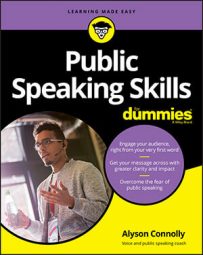How breathing works
When you take a breath in, or inhale, the lungs fill up with air, the ribs expand up and out, and the diaphragm, which is dome-shaped, flattens as the abdominal muscles move down and release. When we exhale, the diaphragm flexes upward, the ribs contract, and the abdominal muscles move in and up as air is expelled from the lungs. The diaphragm has resumed its dome shape.Your core muscles are used to support the release of air from your lungs. The air then passes through your vocal folds. So where do problems arise? Your body doesn’t allow the diaphragm to flatten to its full potential due to tension. You grip those abdominal muscles and exhale all that air that should be coming out of your lungs and into your vocal folds. Instead, you get a wispy sound, called breathiness, kind of like your vacuum makes when the bag’s full.
What breathiness does to credibility
The breathy person sounds like a lazy person, someone who is holding back in life, who doesn’t seem to care. “But it’s not true!” you say. “I’m breathy, and the farthest thing from lazy!” Well, now’s your time to prove it. Maybe it’s not laziness. Maybe it’s a lack of trust in others or in yourself. Maybe you just need a little impetus to sound like you know you can. But make no mistake: Speaking without breath support sounds dull. There’s no room for inflection or resonance, and without that you’re not a very engaging speaker. Breathiness can be caused by lack of breath support and a lack of contact of air at the vocal folds. So to make sure you support your breath at all times, to break that dang habit, see the nearby exercises.Exercises: Beat back breathiness
Exercise 1: Imagine blowing up a balloon. Note how the bottom of the balloon expands first. Imagine that’s how your lungs look too. Breathe in through your nose and try to drop your breath deep into your abdomen. As you fill up your lungs, notice your ribs swing open as you fill up with air. When you exhale, your abdominal muscles should move in and up toward your spine, kind of like rolling up a tube of toothpaste.
I always ask clients to breathe in through their nose because it acts as a cleansing breath. When we breathe through our mouths, we often don’t take as big a breath in to make it feel like we’re filling up the lower abdomen, even though it is our lungs that are actually filling up with air. Breathing through the mouth often causes us to expand only the upper chest, and when you breathe from the upper chest, you can only take short breaths, which aren’t enough to sustain your breath through a long sentence. But breathing through the nose isn’t always possible during a presentation. You often can’t take that time to make sure you have that “belly breath.” So, it’s important to at least learn what it’s like to take that breath in from your nose, and then re-create it while breathing in with your mouth during a speech.
Exercise 2: To feel your abdominal muscles working, try breathing in and exhaling with a “Shhh,” like a librarian. Tell that mischievous library patron a few times: “Shhh, shhh, shhh.” Can you feel your abdominal muscles pull in and up? That means that they’re engaged and working to support your breath.
Exercise 3: This one will help you get that breath support you need, although it takes a bit of math. Well, counting. Anyways: Count to one, and then breathe. Next, count to two, and then breathe. Continue this until you reach 10. How does your body feel? If you feel any tension building up, start over. Do it until you can go all the way through, with no stopping, without any tension building up in your body. Make sure you’re counting with energy. Imagine you’re playing hide and seek and counting before you go off to catch someone.

